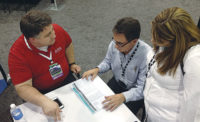Neupert Endowment continues to impact PHCP-PVF industry
School is in session at the American Supply Association.

Central State Group’s Todd Ford is the chairman of ASA’s Endowment Campaign Advisory Board. The Education Foundation is in the midst of raising an additional $3 million for the Karl E. Neupert Endowment, which helps fund the many products and services ASA University offers. Photo by Mike Miazga/Supply House Times.



Central States Group marketing team member Kara Burns goes over the finer points of ASA University’s Essentials of Profitable Wholesale Distribution with coworkers at the Omaha, Neb.-based industrial PVF distributor. In less than a year, the Education Foundation has received $600,000 in pledges and donations toward the Neupert Fund without the aid of a formal marketing program. Photo courtesy of Central States Group.

Burns (left) and Central States Operations Manager Kayla O’Reilly work on an ASA University course. Today, thanks to the Neupert Endowment Fund, ASA University offers 29 role-based training tracks and more than 200 courses. Photo courtesy of Central States Group.





Back during the recession years of 2008-2009, things trended toward bleak for the American Supply Association’s Education Foundation.
“That was my first year on the Education Foundation as a trustee,” recalls Central States Group’s Todd Ford, chairman of the ASA Education Foundation Endowment Campaign Advisory Board. “Sales were gone and the endowment had gone below the original endowment amount and we didn’t have the sales to fund our initiatives and products, plus ASA didn’t have the funds to subsidize the foundation.
“We had no money. There was nothing we could do. We were taking resources and trying to dress them up. We had companies that were not investing in training or retention and were not recruiting people. They were laying people off. It was one of those moments where we had to sit back and say, ‘What is our true direction and where do we need to go?’”
The endowment Ford refers to is the Karl E. Neupert Endowment Fund that had reached the late Tigard, Ore.-based Consolidated Supply owner’s goal of raising $10 million. The endowment hit the $10 million mark in 2006.
Central States Group’s Todd Ford talks about the ASA Education Foundation Karl E. Neupert Endowment Fund.
And as ASA Education Foundation Executive Director Amy Black tells it, without the endowment in place during the recession, the outcome, indeed, would have been grim.
“In 2009, if we didn’t have the endowment, we probably would have dissolved the Education Foundation and then started it up again,” she explains. “But because of the endowment, we were able to stop what we were doing and regroup. That’s when we converted all our book-based courses to an online format, developed the ASA University concept and started developing a wide range of resources.”
Today, the ASA Education Foundation is thriving and in the midst of a capital fundraising campaign aimed to add $3 million to the endowment by 2020. This initiative was started at NETWORK2016 in New York City last fall and already has raised more than $600,000 in pledges and donations without the aid of a formal marketing campaign, Ford and Black note.
“We currently maintain a little more than $12 million in the corpus and since the first initial campaign we have not asked for more for the endowment fund,” Ford says. “The endowment has given the Education Foundation the opportunity to be on our own and still generate, but not have to worry about what the price of an item will be to the membership. It’s more about focusing on the products and services we can offer.”
Ford says based on talks with the endowment’s investment advisors, ideally a university endowment should grow by about 2% a year to continue to work with factors such as inflation and the rising cost of products.
“We certainly want to raise $3 million by 2020, but a secondary goal is to have the ASA membership continue to give so we can make sure we hit that 2% every year so we can continue to fund the changing platforms,” he says.
Up close and personal
Ford, president and CEO at industrial PVF distributor Central States Group, came to the Omaha, Neb.-based company after starting in the industry at a large plumbing wholesaler.
“I started with the ASA training books and then some of the classes went online toward the end,” he says. “I still have my certificate that says I graduated from Plumbing Valves 101. When I came to Central States, we had rows and rows of the books.”
Ford says without the resources of the ASA Education Foundation at Central States’ fingertips, he feels the company would be behind the curve in terms of employee development and retention, limiting its ability to grow, stay relevant and competitive.
Ford notes with 90 employees at Central States there is not that luxury of training spent in one particular part of the company for an extended amount of time.
“Larger distributor firms are big enough where someone could start in the warehouse and work their way up and get that exposure,” he says. “Most companies our size, you can’t take a new hire and send them out for eight months to learn in the warehouse. That’s where ASA University courses help to fast-track the learning curve.”
When he first started at Central States, Ford felt ASA’s training materials were more skewed toward plumbing distributors. That changed in a hurry. “That was my one complaint early on,” he says. “ASA was a plumbing organization and we are an industrial PVF house. But specifically, the development of the 3-D schematics and a focus on industrial training came out of ASA listening and acting, which has helped our whole Industrial Piping Division group. Now, all our drivers, admins, receptionists, AP and AR clerks, everybody goes through a set of training classes to educate them on the industry.”
Changing with the times
Another critical component to think about, Ford says, when it comes to training is being cognizant of the changing forces at work in today’s workplace.
“We have huge issues in our workforce that were uncovered in the labor study the foundation conducted,” he says. “There is a gap between the baby boomers with a lot of industry knowledge getting out of the workforce and the incoming millennial group. With the Gen-Xers there isn’t a very big piece of us. We are getting overtaken.
“We must have products and services and recruiting and retention tools in the mediums these newer employees need to have it in,” Ford continues. “We’ve gone from books to computers and then to fast snippets of information. This is not a sexy industry that people are targeting to be a part of. The trades are losing people and having a difficult time replacing them which affects us. If the trades lose people, we lose people. As the Amazons and Graingers and larger companies take everything digital, we have to put a stake in the ground and create products and services that allow us to fight together and stave them off for however long we need to.”
And Ford is a big proponent of providing the training and education necessary that will show prospective employees a clear-cut career path.
“We know it’s not fancy or flashy or cool to say you sell pipe, valves and fittings,” he says. “That’s our identity as an industry right now. The tools the ASA Education Foundation provide gives us a very inexpensive avenue to get out and create a career path and show these young kids coming in you can start here and here are the steps you can take to have a long and prosperous career in the PHCP industry. That makes us look bigger than we are. Give them a path to where they can say, ‘I can have a career and not just a job.’ At Central States we want people who want careers. And through the efforts of the foundation I can say I can give you a career.”
Overcoming objections
Black has an easy answer for companies who may be hesitating about investing in ASA University training because of perceived cost or not knowing where to start.
“Our perception at ASA is that’s not a barrier. It’s an easy excuse,” she says. “I need 15 minutes of someone’s time and I will put together a recommendation and a starting point. If you don’t know where to start with training, let us figure it all out. I promise we will come up with a training program that is within your budget. Let’s have those conversations and not even talk about money. How can we help your company?”
Ford says the training and education piece in this day and age can’t be overlooked when examining a company’s health both now and into the future. “Get involved,” he says. “Ask the folks at ASA the tough questions. I’ve heard, ‘Well, I’m a small company and there is too much training stuff and we don’t know where to start.’ That’s true, but the ASA Education Foundation staff will guide you on that path and help you figure out what that specific ROI is for your company. But if you don’t make that call, those of us who are using the service and are looking forward and know about the labor study and what is coming ahead, those are the companies that will leave everybody in their dust. If you are not calling, the end is nearer than it should be.”
In terms of the future, Black notes more training materials are on the horizon for talent-development categories such as performance management, career pathing and succession planning to name a few.
“When you are getting these younger people into the business, we can show you exactly what the path is and where the opportunities are and how long it is going to take them to get there,” she says.
Ford says the future of training is about establishing a culture. “ASA with the Education Foundation is putting together the pieces to help you go from your current position to a very open and developing culture where you are attracting younger workers and at least giving them the opportunity to say, ‘I’ll check it out,’” he says.
“Face it. People are only going to go where they are happy and valued. If we didn’t have to work, we’d all be selling snow cones on the beach. The fact is we have to be here and we all want to be somewhere where we can be productive and valued and see a path that can provide for you and your family. This is what the ASA Education Foundation is doing for its members.”
To donate to the Karl E. Neupert Endowment Fund, visit www.asa.net/give or contact Black at ablack@asa.net.
This article was originally titled “School is in session” in the September 2017 print edition of Supply House Times.
Looking for a reprint of this article?
From high-res PDFs to custom plaques, order your copy today!














